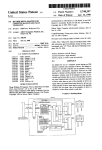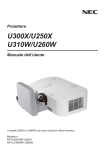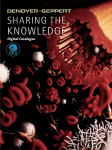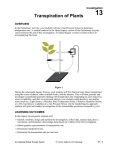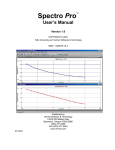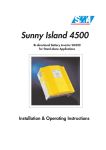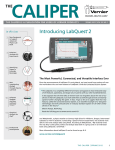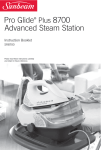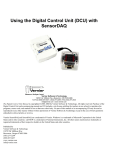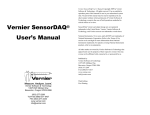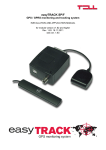Download Fall 2009 - Vernier Software & Technology
Transcript
Fall 2009 | Vol 26 NO.2 Caliper The the caliper is a publication for users of vernier products Now Shipping: the New Vernier Mini GC IN THIS ISSUE 2 New Video Analysis Book for Physics 3 New Activities Using Vernier sensors and MINDSTORMS® NXT® 5 Enzymes in the Laboratory 6 New Vernier Mini GC and Free Labs TM Advanced MEMS GC chip technology allows you to use room air as the carrier gas only $1749 9 10 11 Measure electricity usage with the New Watts Up Pro Logger Pro Updates and Tips Professional Development The new Vernier Gas Chromatograph, or Mini GC, is an instrument for separating, analyzing, and identifying substances contained in a volatile liquid or gaseous sample. It has all of the key components of a traditional gas chromatograph, including an injection port, temperature and pressure controls, a thin capillary column (Restek MXT®-1 stainless steel capillary) through which different substances pass at different rates depending on various chemical and physical properties, and a sensor for detecting the arrival of compounds. It also has the added benefit of a new patented MEMS chip sensor that allows for room air to be used as a carrier gas. Its compact size makes it an ideal solution for students to learn the principles of gas chromatography. continued on page 6 New LabQuest Charging Station Multi-bay charging capability for your LabQuest Want a way to charge and store your LabQuests? The LabQuest Charging Station is the perfect solution. Each charging station has four charging slots. LEDs on the charging station indicate the charging status. The compact design uses desk space efficiently. Because the charger holds four LabQuests, it is easy and affordable to accommodate small and large lab setups. 99 L Q - C R G $ order code VERNIER SOFTWARE & TECHNOLOGY • PHYSICS Math Machines A different way of using technology in math education Math Machines is a non-profit organization that promotes the use of technology in mathematics teaching. The originators of the project are Fred Thomas (physics) and Robert Chaney (math), faculty members at Sinclair Community College in Dayton, Ohio. “Math Machines” are simple devices that convert standard mathematical expressions into immediate, physical actions. Originating in 1998 with grants from NSF’s Advanced Technological Education program, the first Math Machines used TI-83/84 family calculators with LabPro or CBL 2 interfaces to control vehicles, colored lights, pointers, and other physical devices. The project is now focusing its development work on computer controls using Vernier’s SensorDAQ. Perhaps the most versatile Math Machine is basically a hobby servo motor that can be purchased for $10 to $20 from many hobby stores. Using free software and free building instructions from the Math Machines web site, the servo motor can aim a laser pointer, a webcam, a mirror, or wooden rod, and provide an immediate, dynamic response to equations such as 0 = -60 – 4*t or x = -2 + 0.6*t – 0.04*t2 In addition to time, the functions can use real-time data from up to three of Vernier’s sensors as independent variables. Functions can be in analytic form like the ones above or in recursive form such as Physics Video analysis with & ENGINEERING NEW Physics with Video Analysis book By Priscilla Laws, Robert Teese, Maxine Willis, and Patrick Cooney By Priscilla W. Laws Robert B. Teese Maxine C. Willis Patrick J. Cooney ework And lAbs lAssrooms, Hom Activities for c s tools o v i d e o A n A ly s i using logger Pr 48 P VA $ order code Physics with Video Analysis contains 32 new video analysis activities for introductory physics at either the high school or college level. Topics include kinematics, dynamics, circuits, sound, thermodynamics, electrostatics, and more. The activities are centered on a collection of ready-to-go videos created for this book. Collecting good videos for analysis can be challenging, and the provided videos are a delight to work with. Like other Vernier books, Physics with Video Analysis includes printed student versions of the activities, ready to duplicate. Alternatively, you can use the included word-processing files to adapt the activities to your particular students. Complete solutions and instructor notes are included. The activities can be used as homework projects, or as in-class group projects. The book includes a CD with professionally made videos, student activities, solutions, and Logger Pro experiment files. Physics with Video Analysis is a product of the NSF-funded LivePhoto Physics Project. For more information, see http://livephoto.rit.edu/ Activity #19 from Physics with Video Analysis One of the activities in Physics with Video Analysis is “Slinky Wave Speeds.” Several cool videos show both a transverse and a longitudinal wave traveling down the Slinky. The student is asked to consider the motion of just a single coil on the Slinky, and then to measure the two wave speeds. Experiments like this are hard to set up, and are even more difficult to get quantitative measurements. The slow motion videos make it very clear just how the wave travels through the medium—that is, the Slinky. Video analysis is the perfect tool for this project and many more activities. You can download four samples videos, student activity guide, and Logger Pro files from www.vernier.com/cmat/pva.html. The book includes these, and also has an answer key and instructor’s notes. New Photogate Bar Tape Kit Perform experiments much like you would with a traditional “ticker tape timer” For many years, we have carried a photogate accessory called Bar order code $ Tape. Bar Tape is a 3 m flexible, plastic tape that contains alternating TA P E - V P G opaque and transparent bands. The tape can be attached to objects and pulled through the photogate. The tape allows you to perform experiments much like you would with a traditional “ticker tape timer.” We’ve recently updated this product, and it now contains an adapter that neatly holds the tape in position on the photogate. 17 The graphs below show data collected with a toy car. The car had two speeds. From the velocity graph, you can see an initial acceleration, then a nearly constant speed, and then a second acceleration. x = x + 0.6*dt For more information or to sign up for a Math Machines’ workshop, go to www.mathmachines.net 2 Position data for a toy car T h e C alip e r • F all 2 0 0 9 • w w w . v e r n i e r . c o m Velocity data for a toy car VERNIER SOFTWARE & TECHNOLOGY • PHYSICS Video Analysis with High-Speed Cameras STEM 2 ® ® ® MINDST ORMS NXT WITH VERNIE R AND LEGO Collect motion data from fast-moving objects & ENGINEERING New STEM 2 with Vernier® and LEGO® MINDSTORMS® NXT Activities cover core topics in physical science Long before LEGO introduced their MINDSTORMS NXT robotics kit, we started STEM2 working with them on hands-on science and engineering projects using our sensors. Out of this collaboration came our Vernier NXT Sensor Adapter and our first book of labs and projects, STEM with Vernier® and LEGO® MINDSTORMS® NXT. We have now published our second book of projects and labs using Vernier sensors. We think these two books offer great ways to motivate upper middle school and high school students to pursue science and engineering careers. 35 $ STEM 2 with Vernier® and LEGO® MINDSTORMS® NXT has activities using a Force Sensor, Magnetic Field Sensor, Voltage Probe, and Gas Pressure Sensor. It covers topics in physical science and engineering, including mechanics, pressure, electricity, and magnetism. Students are challenged to build and program robots for testing batteries, finding land mines, and controlling a Cartesian diver. Twelve classic labs done with these same sensors and the NXT are also included. Video analysis of a golf swing Casio recently developed a set of high-speed cameras (www.casio.com/products/Cameras/ High_Speed_EXILIM/). These cameras are actually still digital cameras, but they have the ability to capture high-speed video. The capture rates vary from 210 frames per second (fps) to 1200 fps. The price range is from $300 to $1000 per camera. These cameras open exciting opportunities to explore science that is difficult to see at normal speed. Here are a couple of examples: Teachers want to collect motion data from fast-moving objects, such as the speed of a baseball as it leaves the pitcher’s hand, or the speed of a golf ball after being struck by a club. It would be natural to assume that a Motion Detector could help answers these questions, but these objects move too quickly for the Motion Detector; however, video analysis of these fastmoving objects offers a great solution. We measured the speed of a golf club and the speed of the golf ball after impact using a Casio EX-FH20. The figure above shows a frame from the video analysis, and the graph shows velocities of the club head and ball. We’ve posted this analysis on our web site. You can see the video and data analysis at www.vernier.com/innovate/114 order code Magnet tester from STEM 2 String tester experiment from STEM 2 Our original STEM book covers topics in environmental science and engineering, including soil moisture, water quality, acidity, and UV radiation, using a pH Sensor, UVB Sensor, Temperature Probe, Conductivity Probe and Soil Moisture Sensor. It has 14 labs and 4 projects, including building an acidity tester, an aquarium monitor, and a plant watering system. WIT H VER NIER ® STEM AND LEG ® O MIN DST ORM S ® NXT 35 S T E M $ order code Both books include all construction and programming instructions. Each also includes a CD with editable student handouts in Word format and MINDSTORMS NXT sample programs, movie clips, and LEGO Digital Designer files with detailed instructions for building and operating the robotics projects. The Vernier NXT Sensor Adapter The Vernier NXT Sensor Adapter allows LEGO MINDSTORMS NXT robots to use over 30 sensors for sensor-based control systems. order code $ 39 B TA - N X T more online Video analysis of a golf swing Download videos, student activity guide, and NXT files at www.vernier.com/stem2 T h e C alip e r • F all 2 0 0 9 • w w w . v e r n i e r . c o m 3 VERNIER SOFTWARE & TECHNOLOGY • Worm Bin Composting Studying Enzymes in the Laboratory Our newest environmental project at Vernier is composting with a worm bin. Our worm bin is a large, locally made, unfinished cedar chest with about 60 cubic feet of capacity. The bin is located in a shady spot on the side of our building, and contains a colony of red wiggler worms. We collect food scraps and coffee grounds, along with coffee filters, in a compost pail in our kitchen. Volunteers, called the “worm wranglers,” empty the pail into the worm bin several times a day. We also add paper towels and grass clippings to our composting worm bin. The worms turn this portion of our garbage into nutrient-rich compost that we can use on plants around our building. Enzymes are molecules that regulate the chemical reactions that occur in all living organisms. Almost all enzymes are globular proteins that act as catalysts, substances that speed up chemical reactions. Enzymes catalyze reactions by reducing the activation energy for a specific reaction to occur and yet are neither destroyed nor altered during this process. Understanding how enzymes work in biological systems is a critical and difficult concept for students to comprehend. Keeping a colony of red wiggler worms happily composting is not as easy as you might think. If the colony of worms gets too hot or too dry, the worms can die. For this reason, we monitor temperature and carbon dioxide production from our worm bin using a LabQuest, a Stainless Steel Temperature Probe, and a CO2 Gas Sensor. The graph below shows data taken from our worm bin over a period of 50 hours. A 6 V, 12 Ah motorcycle battery served as the power supply for the LabQuest. We monitored the temperature inside the compost heap and CO2 levels in the air in the bin during this period. You can clearly see in the graph that as temperature rises and falls, so does the level of CO2 in the bin. John Melville, our Biology Staff Scientist, developed an advanced laboratory exercise using the Vernier SpectroVis spectrometer and the enzyme tyrosinase. This enzyme is involved in skin coloring in mammals, immunity in insects, and the browning of fruits, tubers, and fungi that have been cut or damaged. If you have any questions about how to adapt your LabQuest to record continuously for more than eight hours, contact John Melville at [email protected] Daily fluctuations in worm bin temperature (red) and carbon dioxide levels (blue) Vernier Software & Technology is a company that is committed to environmental sustainability. We are located in a LEED Gold certified building, we recycle much of our waste, and many employees ride their bikes or take public transportation to work. We even have 128 solar panels on our roof. You can find out all about our solar panels at www.vernier.com/solar/ 4 Tyrosinase catalyzes the amino acid tyrosine into the compound DL-3, 4-dihydroxyphenylalanine or DL-DOPA for short. Tyrosinase then catalyzes DL-DOPA into a compound that spontaneously converts into dopachrome. As shown in the first graph, dopachrome is a compound with a peak absorbance at 468.5 nm, and is very easy to detect and quantify using a Vernier SpectroVis spectrometer. Tyrosinase is an enzyme that lends itself to the student laboratory. The crystal structure of this enzyme from sweet potato has been published (see Klabunde et al., 1998). Enough enzyme for an entire class period can be isolated from a single potato, and the enzymatic conversion of DL-DOPA to dopachrome can be measured in as little as 2 minutes. In addition, many different compounds act as inhibitors and alternative substrates for this enzyme. For example, the conversion of tyrosine to DL-DOPA is the rate-limiting step in this series of reactions. This is clearly shown in the sample data provided in the second graph above, where DL-DOPA is converted to T h e C alip e r • F all 2 0 0 9 • w w w . v e r n i e r . c o m Full wavelength scans showing the conversion of DL-DOPA to dopachrome over a 2 minute period. Graph demonstrating that tyrosinase converts DL-DOPA (red) to dopachrome at a much faster than if tyrosine (blue) is used as the substrate dopachrome at a much faster rate than when tyrosine is used as the substrate. In the first part of this advanced laboratory exercise, students prepare extracts of the enzyme tyrosinase from potatoes. They then compare the reaction rates of two different substrates—tyrosine and DL-DOPA. Students then investigate the role of increasing substrate concentration on enzyme activity. The second part of the lab is a guided inquiry exercise that involves quantitative analysis and the role of inhibitors, pH, or temperature on tyrosinase. A full description of this lab exercise with sample data and graphs can be found at www.vernier.com/innovate/116 If you have any question about this exercise or any of our Advanced Biology with Vernier exercises, feel free to contact John at [email protected] V E R N I E R S O F T W A R E & T E C H N O L O G Y • b i o l o gy & che m istry Vernier Teams with Bio-Rad for Biotechnology Education Studying Biomechanics with Vernier Vernier is very happy to announce a new partnership with Bio-Rad Laboratories, Inc. We have heard from many of you that Bio-Rad is your first choice for biotechnology curricula and equipment. Bio-Rad combines high-quality supplies, equipment, and curricula with outstanding customer service and technical support—things we believe are important to teachers. Vernier’s photodocumentation and gel analysis capabilities are natural complements to the Bio-Rad products you are already using. In this new partnership, Bio-Rad and Vernier will work together to enhance classroom experiences with joint experiments and curricula. Beginning in the summer of 2009, the two companies began co-presenting workshops for educators. Teachers are utilizing Bio-Rad’s tested lab activities for bacterial transformation and DNA electrophoresis along with Vernier’s Blue and White Digital Bioimaging Systems and Logger Pro Software for analysis. Stay tuned for more products from this exciting new collaboration. Easily study the biomechanics of the arm or leg using models Join Bio-Rad and Vernier for a joint workshop at the NABT conference in Denver in November 2009. Visit www.vernier.com/workshops or e-mail Bio-Rad at [email protected] If you have ever wanted to introduce your students to the study of human biomechanics, we have found a great product for you. While attending the Annual Meeting of the Human Anatomy and Physiology Society (HAPS), we came across two excellent interactive models that use Vernier sensors and our LabQuest to study human biomechanics. NEW White Light Transilluminator White Light Transilluminator The company, Denoyer-Geppert, in collaboration with Daniel Lemon and Joe Griswold from the City College of New York, developed fully articulated models of the human arm and leg and a complete set of laboratory exercises. Each model comes with a complete curriculum that incorporates a Vernier Dual-Range Force Sensor and a LabQuest to investigate the forces that are applied to the biceps tendon or Achilles tendon under varying loads and conditions. Our staff scientist, John Melville, has been working with each model, and has also found a way to measure joint angle using our Low-g Accelerometer. A picture of students using the human arm model to measure joint forces and angles with our Logger Pro software can be seen above. The complete curriculum and exercises can be found at www.slworkshop.com/biomechanics.html. You can purchase the models from Denoyer at the following link http://www.denoyer.com. Go to “view products” and choose “human anatomy models”, then select “biomechanics” to see the models. Don’t forget that you will need a LabQuest and a DualRange Force Sensor. If you want to measure joint angle, you will also need to purchase a Low-g Accelerometer. If you have any questions about these models, or any of our Human Physiology with Vernier exercises, contact John at [email protected]. 119 W H T- T R A N S $ order code View gels stained with non-fluorescent, visible stains Our new White Light Transilluminator provides a high-quality transilluminator at an affordable price. An array of white LEDs provides extremely even illumination, while the adjustable light intensity helps you to optimize the image. A built-in ruler allows for easy measurement of migration distances. While our popular BlueView Transilluminator can be used to view gels stained with SYBR Safe and other fluorescent stains, the White Light Transilluminator allows you to view gels stained with non-fluorescent, visible stains. This includes Bio-Rad’s Fast Blast™ DNA stain, used in both their Forensic DNA Fingerprinting Kit and Analysis of Precut Lambda DNA Kit. Methylene blue and many other non-fluorescent visible stains are viewed easily on this newest Vernier biotechnology offering. You can purchase the White Light Transilluminator separately for simple viewing, or purchase the entire White Digital Bioimaging System. The White Digital Bioimaging System allows you to view your gels, capture the image digitally on your computer, and analyze the data using Logger Pro software (sold separately). Setting up the White Digital Bioimaging System White Digital Bioimaging System (Includes: White Light Transilluminator, Imaging Hood, ProScope HR digital USB camera with 1-10X lens, and a ProScope Stand) 599 W H T- D B S $ order code T h e C alip e r • F all 2 0 0 9 • w w w . v e r n i e r . c o m 5 Introducing the NEW Vernier Mini GC It’s affordable: no more long student lines at just one lab GC At $1749, it is many thousands of dollars less than a standard GC. In fact, it is priced low enough that instructors can finally have a GC at each student lab station, rather than have many students share one GC unit. Uses room air as a carrier gas: no tanks of carrier gases at each lab station Using an efficient, softwarecontrolled internal pump system, you can use room air as a carrier gas. You also have the option of connecting other carrier gases to the Mini GC. Connect to a or LabQuest v Vernier’s Mini GC both Windows an computers via a r connection. You c directly to our po handheld for real acquisition. Stude collection, as wel temperature-pre directly from our Free New GC labs from Gas Chromatography Investigations w Each lab comes with extensive instructor information that details preparation of reagents, instructor Lab 1: Using a Gas Chromatograph: Identifying Unknown Compounds • Measure and analyze the retention time of five ketones and a known mixture of the ketones as they pass through a Vernier Mini GC. • Measure and analyze the retention time of an unknown mixture of ketones. Lab 2: Verification of Esterification • Conduct an esterification reaction of ethanol and acetic acid, to produce ethyl acetate and water. Lab 3: Quantifying Substances in a Mixtu • Measure and analyze the GC retention times of the reactants and products involved in synthesizing ethyl acetate. • Measure and analyze the GC retention times of the reaction mixture to confirm the production of ethyl acetate. • Identify the ketones present in an unknown mixture based on retention times. • Measure and analyze the GC standard mixtures. • Analyze the data to determin of ethyl acetate and butyl ac unknown mixture. A copy of this lab manual is included with each Mini G 6 T h e C alip e r • F all 2 0 0 9 • w w w . v e r n i e r . c o m computer via USB C connects to nd Macintosh robust USB can also connect opular LabQuest l-time data ents set up datall as the column essure profiles r software. Use Vernier’s award-winning software for column control, collection, and peak integration With either Vernier Logger Pro for computers or Vernier’s LabQuest App, peak integration analysis and retention-time determination are built right into the software. Patented GC chip technology detects important organic families Based on technology developed by Seacoast Science, the advanced MEMS GC sensor chip detects many important families of compounds, including alcohols, aldehydes, ketones, aromatic hydrocarbons, carboxylic acids, chlorinated hydrocarbons, esters, ethers, and nitriles. 1749 G C - M I N I $ order code Vernier Mini GC Powered by Seacoast Science Price includes two 1.0 μL syringes, AC Adapter, USB cable, User’s Manual, Lab Manual with 5 student experiments, and handy compact carrying/storage case with the Mini GC lab book tips, sample data, and sample graphs. Here is a summary of each lab: ure • Prepare a set of standard mixtures of two esters, ethyl acetate and butyl acetate, starting with a mixture whose composition of the esters is unknown. C retention times of the ne the concentrations cetate in the original Lab 4: Fractional Distillation Lab 5: Investigating Gas Chromatography • Measure and analyze the retention time of ethyl acetate and butyl acetate as they pass through a Vernier Mini GC. • Measure and analyze the chromatogram of a mixture of nine compounds as they pass through a Vernier Mini GC. • Conduct the fractional distillation of a mixture of ethyl acetate and butyl acetate. • Vary the temperature-pressure profile of the Mini GC and observe how the chromatogram is affected by changes in the profile. • Measure and analyze the retention time of the fractions. • Calculate the percent composition of each substance in the mixture. • Determine the best temperaturepressure profile to obtain the best possible chromatographic separation of the mixture. G C , o r d o w n l o a d f ree l a b s a t w w w . v e r n i e r . c o m / g c T h e C alip e r • F all 2 0 0 9 • w w w . v e r n i e r . c o m 7 V E R N I E R S O F T W A R E & T E C H N O L O G Y • l a b q uest LabQuest Updates LabQuest Tips • Use the Draw Prediction command in the Analyze menu to predict what a graph will look like. Many science standards require this step. • Save time and print directly to a USB printer—no need to go through a computer. • The LabQuest has lots of storage space for files. Use it! Take data, save a file. Open the file later to do further analysis, or open the file in Logger Pro. • Update your LabQuest to the latest software. Each version brings more features, and is a free update. • Change the graph match range by setting the y-axis scale in Graph Options before choosing Motion Match from the Analyze menu. • Put your own lab instructions on your LabQuest. See www. vernier.com/labquest/library. html for more information. • Use the new peak integration feature of LabQuest with your exisiting gas chromatorgraph. Connect your GC to LabQuest with the Vernier Instrumentation Amplifier (order code: INA-BTA). 8 • Support for the new Vernier Mini GC gas chromatograph • Support for the Watts Up Pro electrical power meter • New GPS signal strength applet for use with the Vernier GPS sensor • Support of function generator and Power Amplifier when using Logger Pro 3.8 This update is free, and is recommended for all LabQuest users. For download information, see www.vernier.com/labquest/updates 800.0 Run 1 Signal 369.9 mV GC Peak 2-hexanone 4.82 Temperature (°C) • Use the Strike Through Data command in the Graph menu to temporarily ignore some of your data. Struck data will not be used in any analysis, including curve fits. LabQuest 1.3 is now available. This new version of LabQuest software adds a number of new features: Power (W) • Most of the time LabQuest is ready to go when you connect sensors, but if you have a commonly used configuration that is not quite the automatic setup, you can save your LabQuest session as a file. Then, when you need to return to that configuration, just open the file. LabQuest 1.3 Update Signal (mV) • Try the hardware keys to operate LabQuest. Almost all functions can be done without a stylus. You might prefer one way over the other. up d ates 0.0 0.0 Time (min) Time L % Power 119.3 W -30 0.0 Time (s) 150000 Temperature -18.6° C 5679 Hz 77 400 0.0 Time (s) 150000 Time 125,000 s 08:52 AM 08:52 AM Use the new peak integration feature to determine areas and retention times with the new Mini GC % -10 0 4.820 min 7.3 Audio Function Generator File Table 1000 Hz 100 R Run 1 Monitor power use of appliances with Watts Up Pro 12:40 pm The audio function generator has additional wave forms NEW Go! Tweet ® Coming Soon! Free software makes it easy to share sensor data to the internet from anywhere Go!Tweet is a free application that allows students and teachers to publish data from Vernier sensors to the internet for easy access from anywhere. Connect a Vernier Go! device to your computer’s USB port, open the Go!Tweet program, and your data will be on the web in minutes. Students can check the temperature or pH of a classroom aquarium by monitoring the twitter feed of the sensor’s output. Need to know when to water your plant? Set up a Go!Link, Vernier Soil Moisture Sensor, and Go!Tweet to send automatic tweets when the soil needs water. Go!Tweet is free and coming soon. Get more information or sign up for software updates at www.vernier.com/tweet Follow us on Twitter You can see what the temperature is inside the Vernier office by following our twitter feed at http://twitter.com/GoTweetVST_HQ 25 years ago The Caliper T h e C alip e r • F all 2 0 0 9 • w w w . v e r n i e r . c o m We introduced our Temperature Plotter program for Apple II computers, along with 2-Probe and 4-Probe Temperature Systems that connected to the game port. We also discussed compatibility with the new Apple IIc. V E R N I E R S O F T W A R E & T E C H N O L O G Y • science Watts Up with the Freezer? Measure real-time electricity usage with the Watts Up Pro Temperature and power recorded for a home freezer. The temperature falls while the compressor runs. Spikes are from the self-defrost cycle. We decided to do some home testing of a standard basement freezer with the new Watts Up Pro power meter. How much energy is used, and how cold does the freezer get when the compressor is running? To find out, we used a LabQuest and a Watts Up Pro to log the data over a 48-hour period. The graph tells an interesting story and raises several questions: • Why is the pattern so regular? • Why does every other spike in the temperature data go so much higher? What happens to the power use when the temperature spikes? d epart m ent In the Steps of Ireland’s Greatest Scientists While you probably know that Waterford County Ireland is home to Waterford Crystal, you may not know that it was home to Ireland’s two greatest scientists, Robert Boyle and Ernest T.S. Walton. Students at Christian Brothers Boys’ Secondary School, in Dungarvan, Ireland, recently connected with these science greats by visiting their places of birth. To make the trip even more memorable, school principal, John Murphy, had them bring along some Vernier technology. Here is a Google Maps representation of their journey showing the path they traveled. The data were collected using a Vernier GPS sensor and a LabQuest. The color of the path represents the altitude changes as they moved towards the coast, where red represents the highest altitudes and violet the lowest. For complete details on the trip, visit our web site at www.vernier.com/innovate/119 Watts Up Pro calculates a wide variety of data, including maximum watts, frequency, and cumulative costs. Logger Pro or LabQuest App collects data on the following types of data simultaneously: Real Power, Potential, Current, and Apparent Power. More at www.vernier.com/wattsup The Watts Up Pro Connects to a USB port on your computer or LabQuest. Logger Pro 3.8 or LabQuest App 1.3 or newer is required. 145 W U - P R O $ order code Traveling from Lismore castle to Abbeyside, Dungarvan, Ireland more online Watch an annotated screencast describing the full experiment at www.vernier.com/innovate/118 Where have your scientific explorations taken you and your LabQuest? Video Training We have over 65 new training videos on our web site. Whether you are new to data collection, helping someone who is, or just need a three-minute refresher before trying out a new sensor, there is something for everyone on the new video section of our web site. Look for new videos from featured activities this fall in the new Video Training section of our web site. Go to www.vernier.com/videos Antarctica? The Florida Keys? Eastern Europe? Ireland? Send us a picture and data you have collected to share with science teachers around the world. If we publish your photo, you will receive a $100 Vernier gift certificate. Send an e-mail to [email protected] T h e C alip e r • F all 2 0 0 9 • w w w . v e r n i e r . c o m 9 V E R N I E R S O F T W A R E & T E C H N O L O G Y • l o gger Logger Pro Tips •U se Autoarrange (Page menu) to clean up the page. If you don’t like the result, use Edit/Undo. •U se a double-y graph to display data of incommensurate units on the same graph. See Graph Options. • Create a semi-log or log-log graph using Graph Options. • Show or hide curve-fit uncertainties. Double click on the fit information box to adjust. • Use Strike Through Data Cells (Edit menu) to temporarily ignore some data points. • Use the space bar to start or stop data collection, as long as space has no other meaning. • Use Undo Collect (Edit menu) to undo the last data collection. Or, set Logger Pro to automatically store runs, if you prefer. (See Preferences in the File menu.) • Enable or disable curve fitting • Set default folder location; for example, keep your experiment files on a server location where they can be easily modified. • Show larger text or bolder graph lines on screen. • Hide curve fit parameters if desired. Perform a curve fit, double click on the floating box, and deselect Show on Graph. The box will be hidden, leaving only the fitted curve. pro up d ates Logger Pro Updates Logger Pro 3.8 Logger Pro 3.8 is now available. This new release of Logger Pro adds support for the Watts Up Pro electrical power meter and for the new Vernier Mini GC Gas Chromatograph. It will also support the upcoming Windows 7 and Macintosh Snow Leopard operating systems. This new version 3.8 allows control of the Vernier Power Amplifier (order code PAMP) when connected through a LabQuest. And, you can now access the Function Generator of LabQuest via Logger Pro. Both the Power Amplifier and the Function Generator can be controlled during data collection, which opens up interesting experiment possibilities. For the Function Generator, a LabQuest is required, but the Power Amplifier has some function with a LabPro, as well as full functionality with LabQuest. We recommend that all LabPro and LabQuest users update to this new version of Logger Pro for compatibility with the latest computers, and to benefit from other under-the-hood fixes and improvements. This is a free update from any version of Logger Pro 3. For download information, see www.vernier.com/lpupdates Logger Pro and Excel work well together Did you know that it is easy to move data from Logger Pro to Excel or other spreadsheets? Sometimes the specialized calculations available in a spreadsheet are just the ticket to complete the analysis of an experiment. There are several ways to move Logger Pro data into a spreadsheet. The easiest (and often best) way is to use the clipboard. Select the columns in the data table that you want to move and choose Copy from the Edit menu. Then switch to Excel, click the upper-left cell of the region you want to receive the data, and choose paste. For most purposes, this is all you need to do. You may want to set the number of decimal places displayed in Excel, because this process copies the full internal precision of the values from Logger Pro to Excel. The other method makes use of the comma-separated value (CSV) file format, and is perhaps more effective if you have very large amounts of data to transfer. Choose Export As InspireData (CSV), and give the file a name. Then, in your spreadsheet, choose Import (usually found in the File menu) and follow the prompts to import a CSV file. Excel in particular will guide you through the process, but the default choices are all you will need. Finally, don’t forget that you can use this same clipboard technique to copy graphs into a word processor for report preparation. Select the graph, choose copy from the Edit menu, and the switch to your word processor. Paste. You may want to set the graph smaller than is appropriate in Logger Pro so that the text and numbers will be proportionally larger for printing. Science Humor Question #1: A bear in Alaska and a bear in Yellowstone National Park both fall into the water. Which one dissolves faster? Answer: The one in Alaska, because it is polar. - Submitted by Gretchen Stahmer DeMoss Publications Manager Vernier Software & Technology 10 Question #2: What do you get when you cross an elephant with a grape? Answer: Elephant grape sine theta If you have ideas for good science jokes, please send them to Dave Vernier ([email protected]). If we use your joke in the Caliper, you will win a “valuable” prize. T h e C alip e r • F all 2 0 0 9 • w w w . v e r n i e r . c o m Question #3: What do you get when you cross an elephant with a mountain climber? Answer: You cannot cross an elephant with a mountain climber. A mountain climber is a scalar. - Questions 2 and 3 submitted by Eric B. Hochberg Jet Propulsion Laboratory, Pasadena, CA V E R N I E R S O F T W A R E & T E C H N O L O G Y • pr o f essi o na l d eve l o p m ent 2009 Fall Hands-On Workshops - Tulsa, OK Oklahoma City, OK Wichita, KS Topeka, KS Fort Worth, TX Kansas City, MO Dallas, TX Austin, TX San Antonio, TX Corpus Christi, TX Houston, TX Houston, TX Lincoln, NE Omaha, NE Des Moines, IA Minneapolis, MN 10/1/09 10/3/09 10/3/09 10/5/09 10/5/09 10/6/09 10/7/09 10/7/09 10/8/09 10/10/09 10/14/09 10/15/09 10/17/09 10/24/09 10/24/09 10/26/09 10/26/09 10/27/09 10/28/09 10/29/09 - Indianapolis, IN Dayton, OH Madison, WI Columbus, OH Milwaukee, WI Chicago, IL Chicago, IL Cincinnati, OH Lexington, KY Charleston, WV Grand Rapids, MI Detroit, MI Cleveland, OH Pittsburgh, PA San Jose, CA Erie, PA San Francisco, CA Sacramento, CA Buffalo, NY Rochester, NY NOVEMBER ‘09 9/9/09 9/10/09 9/12/09 9/14/09 9/14/09 9/15/09 9/15/09 9/16/09 9/17/09 9/19/09 9/21/09 9/22/09 9/22/09 9/23/09 9/24/09 9/26/09 OCTOBER ‘09 SEPTEMBER ‘09 In these free, four-hour workshops you will have the chance to try the Vernier LabQuest both with a computer and as a stand-alone device. Tips for using Logger Pro software will also be presented. 11/7/09 11/9/09 11/10/09 11/12/09 11/14/09 - Portland, ME Portsmouth, NH Boston, MA Worcester, MA Providence, RI Follow us on Twitter for info about workshops, conferences, and more! www.twitter.com/VernierST more information on all Vernier workshops at www.vernier.com/workshop NEW Vernier Awards 2010 Vernier/NSTA Technology Award Application deadline is November 30th The Vernier Technology Award is your opportunity to be honored for an innovative use of data-collection technology with your students. David Vernier, Northwest Division, Software Award Recipient 2009 Seven awards are offered annually: three high school (grades 9-12), two middle school (grades 6-8), one elementary (grades K-5), and one college. The award consists of $1,000 in cash, $1,000 in Vernier data-collection technology, and up to $1,000 for expenses to attend the 2010 NSTA national conference in Philadelphia. more online Apply online at www.vernier.com/grants/nsta.html Vernier is proud to be recognized as one of the Top 100 Green Companies in Oregon, as well as one of the Top 100 Companies to Work for in Oregon. In addition, Vernier accepted an award from the Portland Business Journal for being one of the 100 Fastest Growing Private Companies in Oregon. Logger Pro, LabQuest, LabPro, Vernier and caliper design, Go!, Logger Lite, Vernier EasyTemp, Vernier EasyLink, and Vernier EasyData are our registered trademarks in the United States. Oregon business award 2005 Philanthropy Award For outstanding contribution in support of educational excellence International award for Logger Pro software Vernier is proud to be recognized for its philanthropic commitment, steady growth, and as one of the Best 100 Companies to Work For in Oregon—for 10 years in a row. Vernier Software & Technology, vernier.com, DataMate, and Graphical Analysis are our trademarks or trade dress. All other marks not owned by us that appear herein are the property of their respective owners. T h e C alip e r • F all 2 0 0 9 • w w w . v e r n i e r . c o m 11 PRSRT STD U.S. POSTAGE PAID Salem, OR Permit No. 526 toll free 888-837-6437 www.vernier.com 13979 SW Millikan Way Beaverton, OR 97005-2886 ADDRESS SERVICE REQUESTED Go green! Would you rather receive this newsletter in your inbox instead of your mailbox? Win a Free LabQuest Prefer to get an e-mail version of this newsletter or our catalog? Go to our web site and sign up for our digital mailings, up-to-date product announcements, innovative lab ideas using Vernier technology, video training updates, and more. When you sign up, we will enter your name into a drawing to win a FREE LabQuest. www.vernier.com/green green code biotechnology • Vernier Teams with Bio-Rad • NEW White Light Transilluminator p. 5 for more information Please pass this newsletter on or recycle it again. White Digital Bioimaging System being used with Logger Pro Software.














